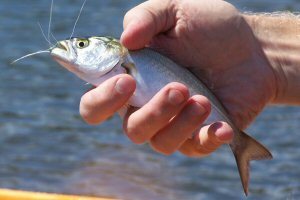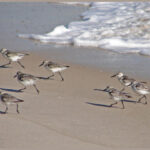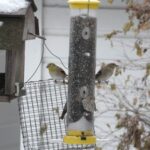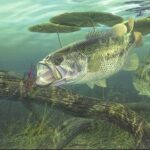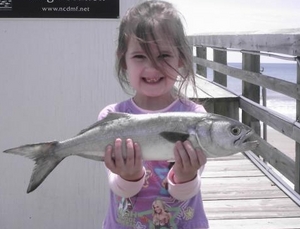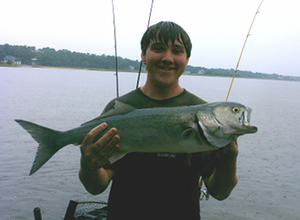Until recently most of my fishing for striped bass has been with lures, topwaters especially. However, as this summer progressed and the temperature warmed the striper fishing became slow. The bass moved into deeper water, and artificial lures were not cutting it anymore. It was only when I witnessed the large schools of juvenile bluefish, also known as snapper blues, move into the harbor where we kept our boat, that it occurred to me that I might be able to make use of these easily obtainable fish.
How to catch the fish...
Snapper bluefish are ravenous feeders, and many baits work well to catch them. Although flashy lures like a Mepps spinner or a small minnow lure can work, I find that live-bait is the most effective way. Snapper bluefish move into the estuaries and shoreline gobbling up everything from grass shrimp to minnows. I’ve caught them on bits of shellfish, bloodworms, and nightcrawlers. However, I find that catching minnows and using them whole or pieces of them are the best way. It does not matter if they are alive or dead, but they should be fresh. Frozen minnows work equally as well. Silversides, mummichogs, and virtually any type of minnow can be used. Refer to my “Best Live Bait for Largemouth Bass: Nightcrawlers and Minnows” article, for guidance on how to catch minnows. Let the bluefish take your bait for a few yards, and then set the hook with a quick jerk. Tip: Sight- fishing bluefish in clear water can be a big advantage, as it allows you to see of your bait is in the fish’s mouth, or just being torn up by a school of hungry snapper bluefish. Warning: Although small, snapper blues have little sharp teeth that can break the skin. Although not really dangerous at all, I wouldn’t purposely put my fingers in it’s mouth if I were you.
Using the juvenile bluefish to catch striped bass...
Assuming you are taking a boat to your fishing destination, put the bluefish in your live-well. The more fish the more oxygen you’ll need, so an aerator always helps to keep the fish alive. The next step is to find a good spot to start fishing; search the waters for any drop-offs, birds, or shoals. You want a single hook attached to a steel leader (to protect against bluefish). The hook should be fairly large,but not so large that it weighs the fish down. Hook the juvenile bluefish through the back or lips, and live-line it, that is, let it swim around on your hook with your bail open.
Lift up your rod tip periodically to see if you have a fish, or watch your bail to see if the line is tearing off the spool. Of course, a bait-runner reel can allow your fish to swim without opening the bail.
When you have a fish, set the hook with a sharp upward jerk. Don’t be surprised if the fish is large; The big ones often are not fooled by lures, but can’t resist taking a helpless fish. Good luck!
